Gonzaga
Author: Guglielmo Duccoli
Publisher: Abacussspiele
Year: 2009
review by

| x |
|
|
|
|
|
|
|
|
|
|
|
|
|
|
|
|
|
|
|
|
|
|
|
|
|
|
|
|
|
|
|
|
|
|
|
|
|
|
|
|
|
|
|
|
|
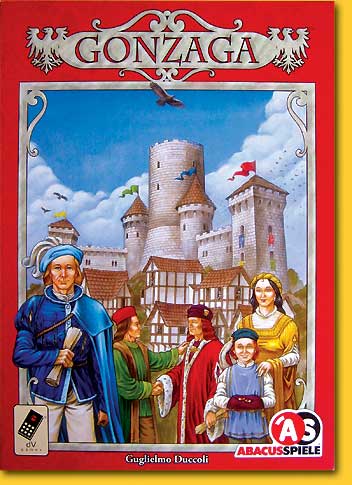 |
'Includes modelled plastic components', it says on the back of the box. Erh, is that supposed to be a recommendation? Only after opening of the stuffed box we see that Gonzaga is indeed something special: four sets of twelve of these pieces, in four bright colours, meant to be placed at the included map of Europe.
The name of the game refers to an Italian family that ruled the north of Italy for 400 years. The players follow this example by trying to make their sphere of influence as large as possible
In Gonzaga, Europe is represented by a nice large gameboard that shows a medieval Europe divided in six regions: Hispania, Italia, Germanica, Britannica, Francia, and Europa Orientalis. The board is also divided into hexagons. Each region has four positions that are marked as a city and four as a harbour.
|
|
| x |
|
|
|
|
|
|
|
|
|
|
|
|
|
|
|
|
|
|
|
|
|
|
|
|
|
|
|
|
|
|
|
|
|
|
|
|
|
|
|
|
|
|
|
|
|
| At the start of the game each player gets his twelve plastic components that represent the fiefs, a set of cards, and six plastic rings, which are placed on his player sheet. The differently shaped fiefs are used to cover three or four hexes on the map. Cards determine which and where each piece will be placed. |
|
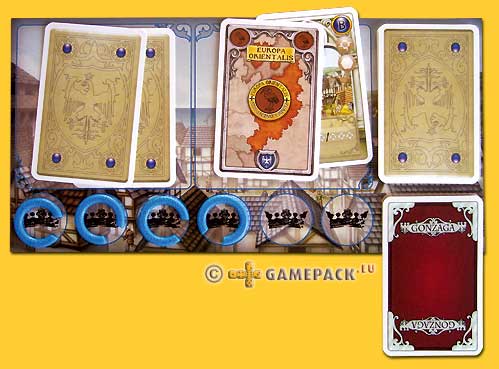 |
| x |
|
|
|
|
|
|
|
|
|
|
|
|
|
|
|
|
|
|
|
|
|
|
|
|
|
|
|
|
|
|
|
|
|
|
|
|
|
|
|
|
|
|
|
|
|
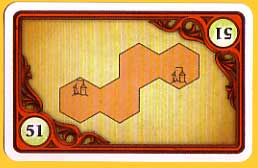 |
|
Each player's card set consists of four different types: twelve cards depicting each of the fiefs, the six region cards, three action cards and a king card. The fief cards are shuffled and form a blind stack. Also each player gets a secret objective card depicting six cities that score extra points at game end when covered. |
|
| x |
|
|
|
|
|
|
|
|
|
|
|
|
|
|
|
|
|
|
|
|
|
|
|
|
|
|
|
|
|
|
|
|
|
|
|
|
|
|
|
|
|
|
|
|
|
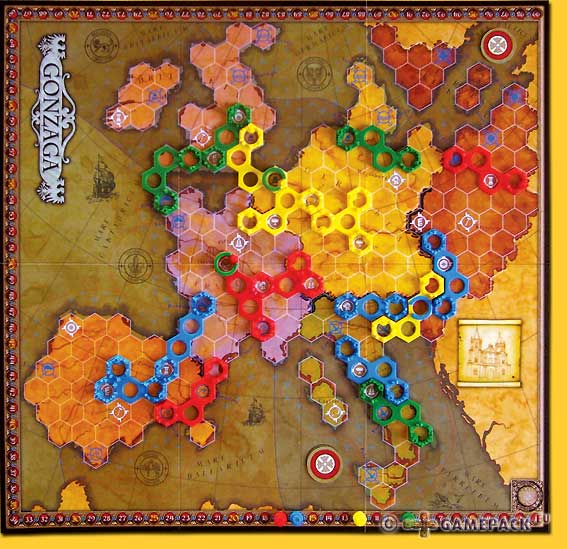 |
| x |
|
|
|
|
|
|
|
|
|
|
|
|
|
|
|
|
|
|
|
|
|
|
|
|
|
|
|
|
|
|
|
|
|
|
|
|
|
|
|
|
|
|
|
|
|
Gonzaga is played in seven to twelve rounds, each round having four phases. Determining the fief piece and deciding where it will be placed form the first two phases. The action cards determine who may play first, and collect one to three points for placing his fief piece by covering cities or harbours. When a player has covered three harbours of the same kind, he immediately scores ten points. The secret objectives score at geme end and score up to 35 points if all six cities are covered with a player's fief piece. Finally a bonus for longest chain scores 15 points.
|
|
 |
| x |
|
|
|
|
|
|
|
|
|
|
|
|
|
|
|
|
|
|
|
|
|
|
|
|
|
|
|
|
|
|
|
|
|
|
|
|
|
|
|
|
|
|
|
|
|
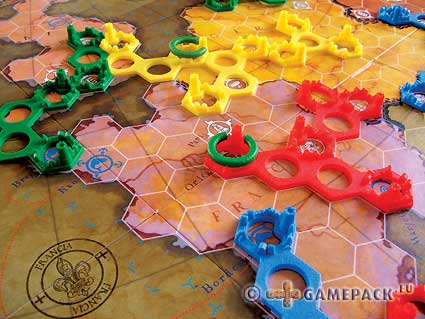 |
|
During the second phase, players choose a region where they want to play their fief piece, and the way it is placed. When this is done, players make their move according to the played action card, with a player having played the king card going first. |
|
| x |
|
|
|
|
|
|
|
|
|
|
|
|
|
|
|
|
|
|
|
|
|
|
|
|
|
|
|
|
|
|
|
|
|
|
|
|
|
|
|
|
|
|
|
|
|
| After this, players with action A may make their move, and then players with action B and C. When a player cannot or does not want to play a piece, for instance because another player place a piece on a planned location before him, as an alternative he may donate tot he church, scoring three points.With action C a player may, instead of playing his piece, place one or two of his rings, even on top of another player's piece. This way a player can occupy an already taken city that he needs for the end game objective card. |
|
|
| x |
|
|
|
|
|
|
|
|
|
|
|
|
|
|
|
|
|
|
|
|
|
|
|
|
|
|
|
|
|
|
|
|
|
|
|
|
|
|
|
|
|
|
|
|
|
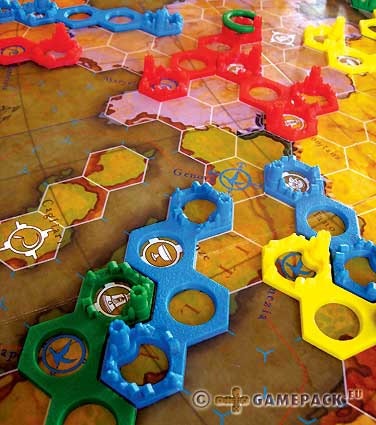 |
After placing his piece or rings the player scores for covered cities and bonuses for harbours. Played cards are placed aside; these may only be taken after the next round, not being available for one round, making it impossible to choose the same region and action twice in a row!
From the start of the seventh round and every round thereafter, players check to see if the current round will be the last one, triggered by a certain number of uncovered cities on the board. If not, the game continues, eventually till all twelve pieces have been placed. At game end, the player with the most points may crown himself King of Europe!
|
|
| x |
|
|
|
|
|
|
|
|
|
|
|
|
|
|
|
|
|
|
|
|
|
|
|
|
|
|
|
|
|
|
|
|
|
|
|
|
|
|
|
|
|
|
|
|
|
| x |
|
|
|
|
|
|
|
|
|
|
|
|
|
|
|
|
|
|
|
|
|
|
|
|
|
|
|
|
|
|
|
|
|
|
|
|
|
|
|
|
|
|
|
|
|
| x |
|
|
|
|
|
|
|
|
|
|
|
|
|
|
|
|
|
|
|
|
|
|
|
|
|
|
|
|
|
|
|
|
|
|
|
|
|
|
|
|
|
|
|
|
|
 |
|
|
|
|
|
|
|
|
|
|
|
|
|
|
|
|
|
|
|
|
|
|
|
|
|
|
|
|
|
|
|
|
|
|
|
|
|
|
|
|
|
|
Gonzaga plays nice. The rules are quick explained, and the game can be played quick too, although it offers enough nasty choices: scoring 'sure' points now, or maybe more later? During play other, more subtle aspects of the game become clear: the power of the king card to be the first to place a piece, and the possibilities of the rings to achieve the longest chain.
|
|
| x |
|
|
|
|
|
|
|
|
|
|
|
|
|
|
|
|
|
|
|
|
|
|
|
|
|
|
|
|
|
|
|
|
|
|
|
|
|
|
|
|
|
|
|
|
|
| The fluent game play is caused by the simultaneous choosing actions of the players. Playing the game with two players feels a bit flavourless: there is plentyfull space on the board for placing the pieces, making the achievement of the end bonus an easy task, especially when the other player most likely will have different objectives. Four players bother each other to the bone, revealing that it really is hard to plan anything with a random drawn and to be placed fief piece and only so little actions to choose from. With three players the balance between planning and chaos seems to be the best. |
|
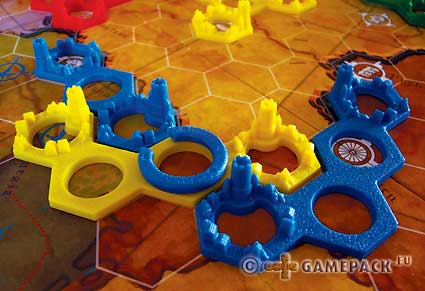 |
| x |
|
|
|
|
|
|
|
|
|
|
|
|
|
|
|
|
|
|
|
|
|
|
|
|
|
|
|
|
|
|
|
|
|
|
|
|
|
|
|
|
|
|
|
|
|
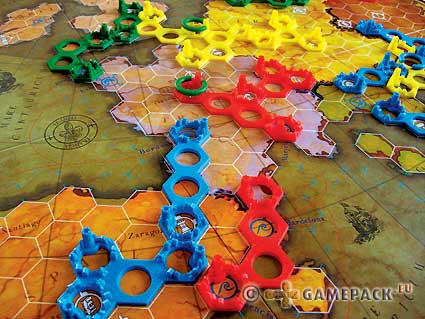 |
|
The game mechanics of 'Gonzaga' cannot be called very new or even revolutionary but the way the playing pieces are produced can be called as such. De spelelementen van Gonzaga zijn niet nieuw te noemen, de uitvoering met de plastic speelstukken is dat wel. From a designer's point of view the colours clash with the more restrained colours of the game board, but it must have been a compromise between functionality and design, decided in the disadvantage of the latter. |
|
| x |
|
|
|
|
|
|
|
|
|
|
|
|
|
|
|
|
|
|
|
|
|
|
|
|
|
|
|
|
|
|
|
|
|
|
|
|
|
|
|
|
|
|
|
|
|
Is 'Gonzaga' a game to recommend to every one? Not quite. Giving the fact that this is a typical family game, it comes in handy when a player can make a mental picture of how the fief piece can be place optimally. This can be far from trivial. Where in other games a player could try to see if a playing piece fits, he would give away his plans in 'Gonzaga'. Handling this kind of mental placement is not everybody’s piece of cake.
© 2010 Edwin van de Sluis
Gonzaga, Guglielmo Duccoli, AbacusSpiele, 2009 - 2 to 4 players, 8 years and up, 45 minutes
|
|
|
|
  |
|
|
|
|
|
|
|
|
|
|
|
|
|
|
|
|
|
|
|
|
|
|
|
|
|
|
|
|
|
|
|
|
|
|
|
|
|
|
|
|
|
  |
|
|
|
|
|
|
|
|
|
|
|
|
|
|
|
|
|
|
|
|
|
|
|
|
|
|
|
|
|
|
|
|
|
|
|
|
|
|
|
|
|
  |
Very dry and technical piece placement game fails to deliver any thrill or excitement |
  |
|
|
|
|
|
|
|
|
|
|
|
|
|
|
|
|
|
|
|
|
|
|
|
|
|
|
|
|
|
|
|
|
|
|
|
|
|
|
|
|
|
  |
Behind the plastic appearance a nicely playing family game is uncovered |
| x |
|
|
|
|
|
|
|
|
|
|
|
|
|
|
|
|
|
|
|
|
|
|
|
|
|
|
|
|
|
|
|
|
|
|
|
|
|
|
|
|
|
|
|
|
|
| x |
|
|
|
|
|
|
|
|
|
|
|
|
|
|
|
|
|
|
|
|
|
|
|
|
|
|
|
|
|
|
|
|
|
|
|
|
|
|
|
|
|
|
|
|
|
 |
|
|
|
|
|
|
|
|
|
|
|
|
|
|
|
|
|
|
|
|
|
|
|
|
|
|
|
|
|
|
|
|
|
|
|
|
|
|
|
|
|
 |
|
|
|
|
|
|
|
|
|
|
|
|
|
|
|
|
|
|
|
|
|
|
|
|
|
|
|
|
|
|
|
|
|
|
|
|
|
|
|
|
|
| x |
|
|
|
|
|
|
|
|
|
|
|
|
|
|
|
|
|
|
|
|
|
|
|
|
|
|
|
|
|
|
|
|
|
|
|
|
|
|
|
|
|
|
|
|
|
 |
|
|
|
|
|
|
|
|
|
|
|
|
|
|
|
|
|
|
|
|
|
|
|
|
|
|
|
|
|
|
|
|
|
 |
|
|
|
|
|
|
|
|
|
|
|
|
|
|
|
|
|
|
|
|
|
|
|
|
|
|
|
|
|
|
|
|
|
|
|